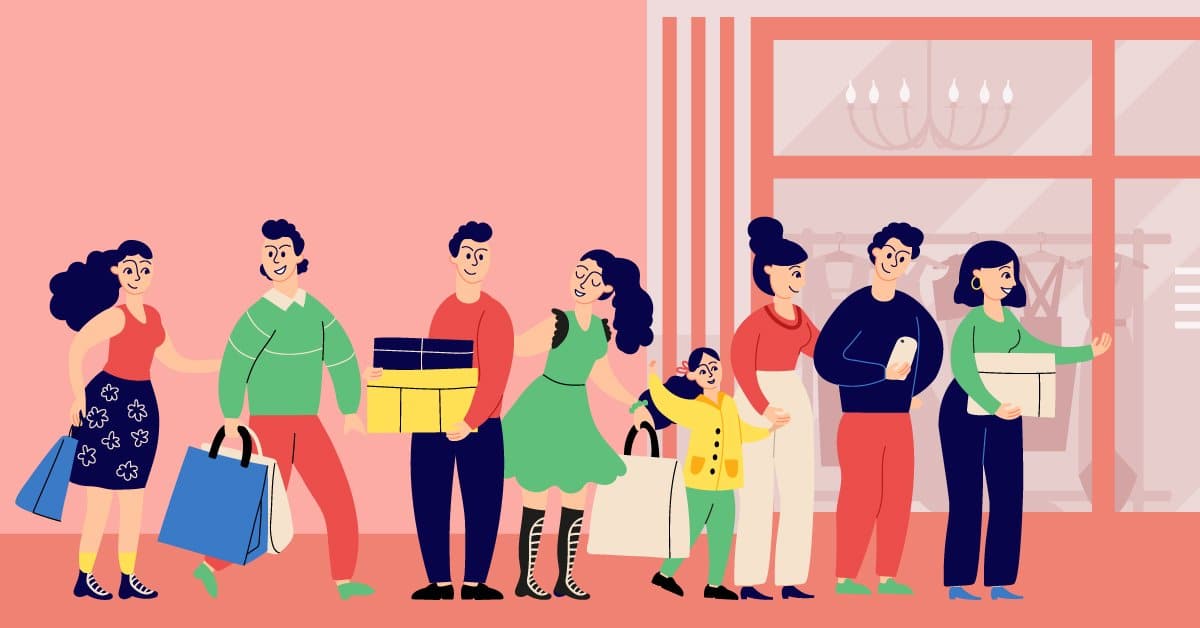Strong customer retention is one of the core components of a successful ecommerce brand. If you’re always chasing new customers and ignoring your loyal customers, you’re destined to have a below-average marketing ROI. After all, the cost of acquiring a new customer is often five times higher than the cost of retaining an existing customer.
One of the best marketing strategies to increase customer retention is a loyalty program.
Benefits of loyalty programs include:
- Increased purchase frequency. The main goal of a loyalty program is to bring current customers back to your store.
- Increased customer lifetime value. The byproduct of increased purchase frequency is an increased customer lifetime value — which is one of the best indicators of a successful online store.
- Increased customer engagement. Loyalty programs are great for generating customer engagement on social media platforms because you can motivate your loyalty program subscribers.
- Stronger customer relationships. We’ve said it before, and we’ll say it again: good marketing is all about relationship building. A customer loyalty program is a great way to take care of your customers and build a long-term relationship.
- Acquire more new customers. That’s right — you can gain more new customers with a loyalty program. That’s because loyal customers are more likely to refer their non-members (like their friends and family) to your store — especially if your loyalty emails have some referral component.
- More brand loyalty. It’s every marketer’s dream to build a brand powerful enough to sell itself (think Starbucks, Nike, etc.). While we’re not saying that a loyalty program will turn you into the next Nike, it can improve your customer experiences and lead to strong brand loyalty.
- Gamify your store. Marketers love to talk about gamification. Creating a program with loyalty points is a great way to gamify your store. You can offer bonus points for specific activities (like recruiting new members or making a purchase) and provide a big reward once someone receives enough points.
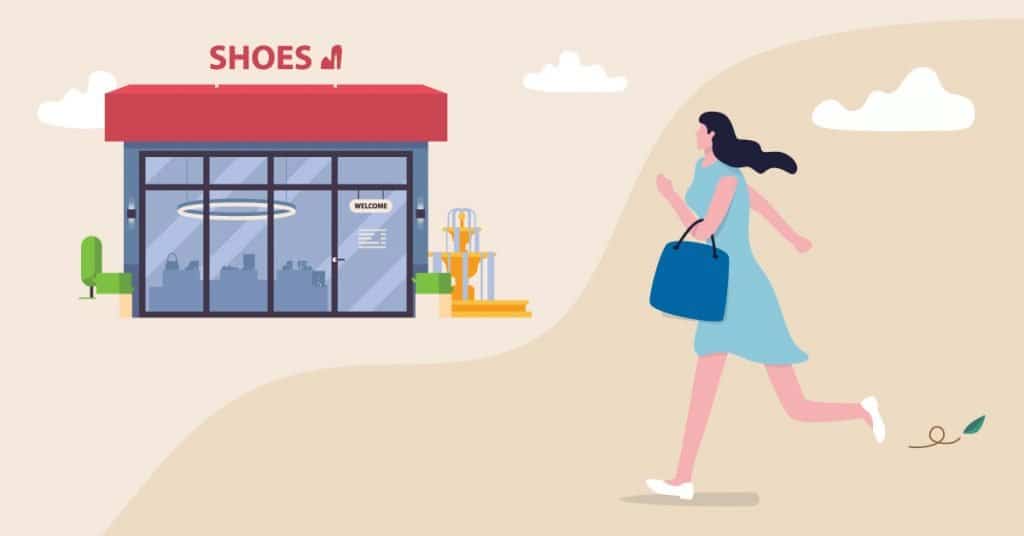
Loyalty Program Email Best Practices
As with any email marketing you do, your loyalty rewards emails should include content and designs that are brand-appropriate, and you should also pay attention to what works well for your audience. Here are some general best practices to consider when creating loyalty program email campaigns.
- Write strong subject lines. Subject lines between six and 10 words tend to perform best, and since most people check email on their mobile devices, you’ll want to put the most important words at the beginning. Words that create a sense of urgency or tie into emotion work well, but you want to avoid anything that might look like spam. That includes strings of random punctuation.
- Always include a CTA. Tell your readers what they should do next. Test the placement of the CTA in the email to find what works best for your audience. Start with a button or link above the fold—that means people don’t have to scroll down to see it—and try other areas from there.
- Keep emails short. Your loyal customers are busy, and most don’t want to see a wall of text thrown their way. Emails that include around 200 words or less of text—or about 20 lines—tend to perform best. However, that’s obviously dependent on your audience, so don’t be afraid to try different formats. Newsletters are one type of loyalty program email, for example, where you might go well above that word count if people are engaging with your content.
- Mostly stick to one idea. Outside of newsletters, which might provide information on a few topics, it’s generally a good idea to have one major point in an email. If you’re sending out a points update, for example, keep it on topic: Here are the points you have. Here are some things you might want to do with those points. Thanks for being such a loyal customer, we appreciate you!
- Remember that people scan emails. Most people don’t read every word in promotional emails. Consumers tend to read the first couple of lines all the way left from right. After that, they scan vertically, picking out the main points that are relevant to them. If someone can’t scan your email in less than 30 seconds and get the main information, they may just delete it and move on. So, use subheads, images, bulleted lists and other formatting and media to create scannable copy.
If you’re always chasing new customers and ignoring your loyal customers, you’re destined to have a below-average marketing ROI. After all, the cost of acquiring a new customer is often five times higher than the cost of retaining an existing customer.
One of the best marketing strategies to increase customer retention is a loyalty program.
Benefits of loyalty programs include:
- Increased purchase frequency. The main goal of a loyalty program is to bring current customers back to your store.
- Increased customer lifetime value. The byproduct of increased purchase frequency is an increased customer lifetime value — which is one of the best indicators of a successful online store.
- Increased customer engagement. Loyalty programs are great for generating customer engagement on social media platforms because you can motivate your loyalty program subscribers.
- Stronger customer relationships. We’ve said it before, and we’ll say it again: good marketing is all about relationship building. A customer loyalty program is a great way to take care of your customers and build a long-term relationship.
- Acquire more new customers. That’s right — you can gain more new customers with a loyalty program. That’s because loyal customers are more likely to refer their non-members (like their friends and family) to your store — especially if your loyalty emails have some referral component.
- More brand loyalty. It’s every marketer’s dream to build a brand powerful enough to sell itself (think Starbucks, Nike, etc.). While we’re not saying that a loyalty program will turn you into the next Nike, it can improve your customer experiences and lead to strong brand loyalty.
- Gamify your store. Marketers love to talk about gamification. Creating a program with loyalty points is a great way to gamify your store. You can offer bonus points for specific activities (like recruiting new members or making a purchase) and provide a big reward once someone receives enough points.
Running a Loyalty Program
Setting up a loyalty program is a lot of upfront work. But, thankfully, you can use automation to make the actual maintenance a little less time-consuming (or you can hire a lifecycle marketing agency to handle it for you).
Let’s run through the basics of setting up and running a loyalty program (don’t worry, we’ll get to the loyalty program email examples soon).
Create a Goal
When starting a loyalty program, you’ll want to make a clear goal so you can measure success later on. For example, your goal could focus on monetary value, like increasing your customer CLV. Or, it could be something like growing your email list.
Determine Your Incentives
One of the fun parts of running a loyalty program is figuring out what rewards and perks you will offer! Similar to running a giveaway, you need to find a balance between what will get people to sign up and participate and what is still profitable for your business.
In our experience, VIP programs that offer points for specific actions are a great way to build loyalty because they allow you to provide different incentives for different tiers.
For example:
- Tier One (for new members) – Free shipping on all orders
- Tier Two (for members who hit a certain threshold) – $20 off next order
- Tier Three (for VIP members) – Free $100 gift card
Of course, your incentives will depend on your goal. So don’t be afraid to experiment to find what works best for you and your members.
Recruit Loyalty Program Members
The next step is to get people to sign up for your rewards program. The best place to start is with your current email list. Send out an email and invite people to join your program.
Once you reach out to existing subscribers, recruit new subscribers with forms on your website. You can also add a checkbox to your checkout process so people can opt-in while they’re making a purchase.
In all cases, it is best to offer an incentive off the bat. For instance, you could let protentional members know that they will get free shipping on all future orders.
Manage Logistics
Many of the functionality associated with loyalty programs, including email marketing, points structures and redemptions, can be automated. But that doesn’t mean these programs are set-and-forget marketing. Instead, you must pay attention to analytics to learn the best times to send offers and whether certain rewards are still pulling their weight in your program.
There are many apps on the Shopify Marketplace, like Smile, that can assist you with loyalty program logistics.
Figure Out Your Email Marketing Strategy
Most of your loyalty rewards customers aren’t hovering on your site constantly or hitting up their account profile daily to see what offers and points are available. You must reel them in repeatedly with loyalty program emails and offers — reminding them of the program and how much they have to gain by engaging with it.
- Welcome email. This is an automated email that welcomes someone to the program. Your welcome email should include information on redeeming their signup reward and the primary benefits of the program.
- A newsletter. Loyalty program email newsletters provide your best customers or members of your rewards program with added value that no one else gets. For example, you might use newsletters to provide exclusive behind-the-scenes information, updates on new products before anyone else sees them and special offers.
- Offer emails. Loyalty programs are often about rewarding customers who support you the most, so offer emails are expected. For example, you might send out a promotional offer for your best customers or even have an offer email automated to go to loyal program members who haven’t shopped with you in a certain amount of time. This can help remind them they’re part of the program and what benefits are waiting for them.
- Special day emails. The most common of these types of emails is birthday emails; many businesses offer freebies or discounts for someone’s birthday. But even if you don’t have something to offer, sending out sincere well-wishes can be a way to let people know you care about them and remember them. Other special day emails can include holiday emails or even those recognizing some obscure national awareness day relevant to your products, audience or brand.
- Points updates. Another very legitimate way to show up in the inbox of your loyalty program members is with an update on their points or rewards. You might allow them to opt-in to automated updates so they receive a monthly email that lets them know how many points they’ve earned and gives them a summary of rewards options. This helps remind them of the program and entice them to return and make another purchase. For example, if someone has 495 points and only needs 500 for redemption, the email might point out this fact and provide a list of a few products that would net those five points. If points expire, you can also automate emails to remind people to use them.
Loyalty Program Email Best Practices
As with any email marketing, your loyalty rewards emails should include brand-appropriate content and designs, and you should also pay attention to what works well for your audience. Here are some general best practices to consider when creating loyalty program email campaigns.
- Write strong subject lines. Subject lines between six and ten words tend to perform best, and since most people check email on their mobile devices, you’ll want to put the most important words at the beginning. Words that create a sense of urgency or tie into emotion work well, but you want to avoid anything that might look like spam. That includes strings of random punctuation.
- Always include a CTA. Tell your readers what they should do next. Then, test the placement of the CTA in the email to find what works best for your audience. Start with a button or link above the fold and try other areas from there.
- Keep emails short. Your loyal customers are busy. Therefore, emails that include around 200 words or less of text — or about 20 lines — tend to perform best. However, that’s dependent on your audience, so don’t be afraid to try different formats. Newsletters are one type of loyalty program email, for example, where you might go well above that word count if people are engaging with your content.
- Stick to one idea. Outside of newsletters, which might provide information on a few topics, it’s a good idea to have one central point in an email. If you’re sending out a points update, for example, keep it on topic: Here are the points you have. Here are some things you might want to do with those points. Thanks for being such a loyal customer. We appreciate you!
- Remember that people scan emails. Most people don’t read every word in promotional emails. Instead, consumers tend to scan vertically, picking out the main points that are relevant to them. If someone can’t scan your email in less than 30 seconds and get the primary information, they may delete it and move on. So, use subheads, images, bulleted lists and other formatting and media to create scannable copy.
7 Great Loyalty Program Emails, What Works for Them and What Doesn’t
We’ve dropped a lot of information on you about marketing emails — and loyalty rewards emails in particular. To help cement your learning and let you see how this information works in real life, let’s look at seven loyalty program email examples and discuss what works and doesn’t work for each.
1. The Points Notfication Email
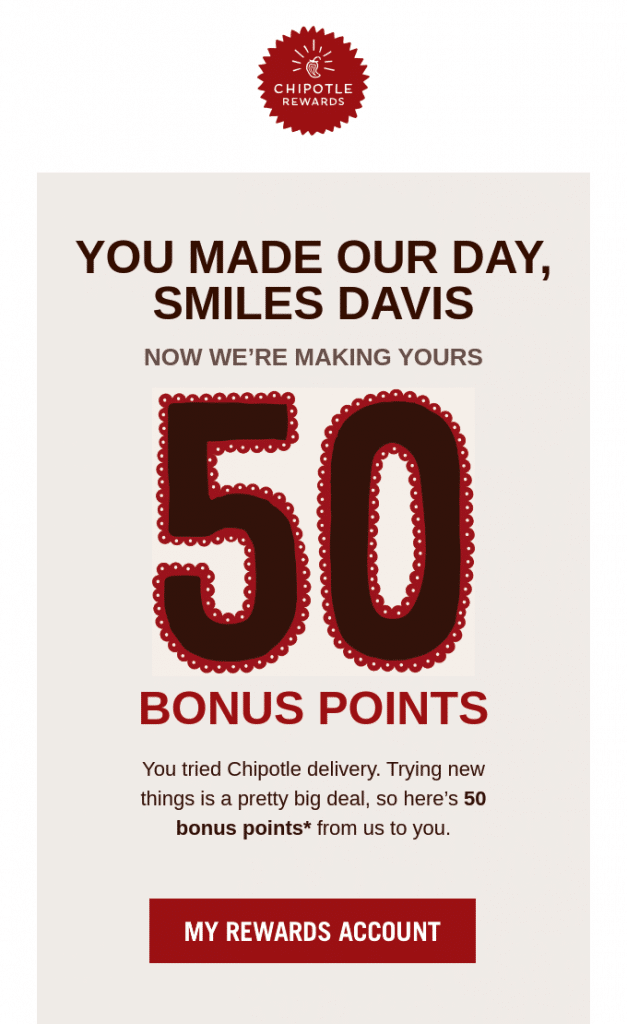
This loyalty program email from Chipotle is great because it gets right to the point. The rewards member ordered Chipotle delivery so this email is giving them 50 extra bonus points. So not only does this bring joy to the subscriber (yay, free points!), it also brings them closer to their next reward — which will mean another purchase at Chipotle.
2. The Summary Email
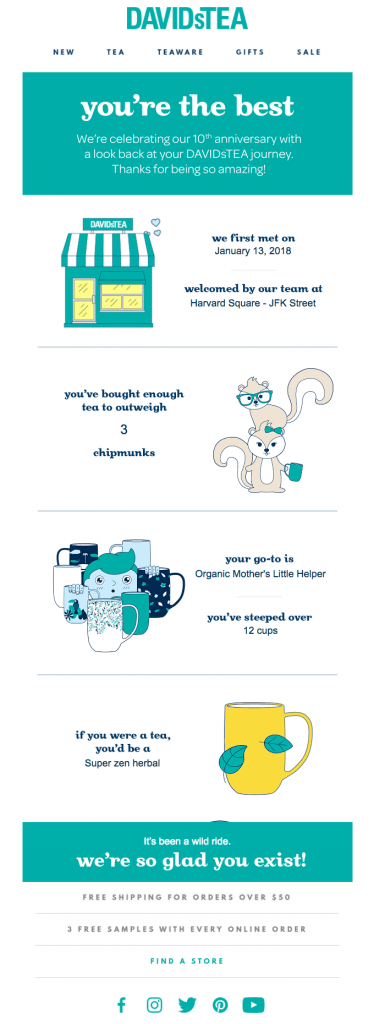
People love personalized messages and this email from David’s Tea does a great job providing fun and engaging content that is unique to the subscriber. We also love that the images incorporate the brand colors. One thing we would love to see in this email is an option to share the image on social media.
3. The Holiday or Special Day Email
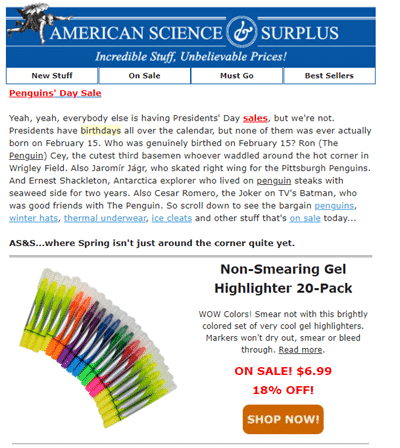
This email loyalty program email from American Science & Surplus is clever. The marketing team for this brand obviously looked at their content calendar for February and saw that President’s Day was coming up. As you’re probably aware, many people run President’s Day sales, which means a lot of emails hitting inboxes for those promotions.
It’s a bit arbitrary — why create a sale in honor of a day to celebrate presidential birthdays when, in fact, it was not a president’s birthday? American Science & Surplus plays on this question and has a Penguins’ Day Sale instead, setting them apart in people’s inboxes for that week.
The fun introduction in this email is a bit long, but it works for the target audience. People shopping at American Science & Surplus are typically interested in learning and exploring odd facts and knowledge, so they might appreciate this paragraph full of trivia. And even if they don’t, the large promotional images that follow make it easy to skip ahead to the meat of the offer.
This image doesn’t cover the entire email, which is pretty long. There are numerous other product images and sales offers with shop or buy now buttons. One of the benefits of this structure is that people are more likely to find something that interests them personally, increasing click through rates.
On the downside, the wordy, long and image-heavy email may get deleted by many who don’t have time to shuffle through it all.
4. Expiring Offer Emails

This email from Book Outlet is the opposite of the one from American Science & Surplus. It’s very short and has one offer: Save when you shop now. It also includes a very specific deadline of March 17 at 10 a.m., which was only 24 hours from when this particular email arrived in the inbox.
Book Outlet’s email works on several levels:
- The design is bold, enjoyable and easy to engage with. It also hints at spring, something many people are likely to be craving around the middle of March. Aligning its message with the desire for warmer days helps Book Outlet encourage positive emotional connections to drive more clicks.
- It’s easy to read. You get the message with a scan of fewer than ten words in this email. The offers are bold and easy to see, and when people scan the email, they’re led to the “shop now” button as a conclusion on the message.
- The deadline on the email creates urgency. When coupled with a subject line that does the same, this type of email can convert customers who want to make a purchase but would otherwise put it off for any number of reasons, including that they just don’t want to be bothered at the moment.
There aren’t many downsides to this email from Book Outlet. Sure, anyone who doesn’t open and read the email within 24 hours is unlikely to click through or engage because they know they missed the deal. But that’s okay: it may improve open rates on your subsequent emails because people will be conditioned to watch for them and open them lest they miss another deal.
5. Bonus or Exclusive Content Emails

Indie author Selina R. Gonzalez sent this email to her newsletter followers — her loyal readers — before a new book release. This was the first place she revealed the cover of the upcoming book, and she also provided her readers with information on exclusive content and product offers.
This email is an excellent example of how you don’t necessarily need a full-fledged program to start offering rewards. What works for this message is that people are getting value because they’re a loyal reader— and it’s value that’s important specifically to that niche audience.
Gonzalez also does something clever with this email. The image included is the same image she later included on her social media profiles; that helps create cohesive and memorable messaging across all channels. People on her list later see that messaging and realize they saw it first, increasing the engagement as a loyal customer.
6. Offers and Freebies Emails

Your loyalty program is about rewarding good customers so they’re persuaded to return to your shop or store to make more purchases. You can do that by sending out updates on points or rewards tiers to let people know what value they can get. You can also offer freebies and other promotions that are exclusive to people with membership in your program.
This email from Big Lots is a great example. Like many other stores, Big Lots has a card membership option. When you scan your card at checkout, you rack up rewards points that help you save on future purchases. You also get exclusive coupons and discounts, including free product offers.
This email works for a few critical reasons:
- It aligns with the core value prop of the store and its rewards programs. People shop at this store to get bargains, and what’s a better deal than free?
- It sets a date to create urgency. If you want the offer, you have to act soon.
- The offer is a loss leader. A bag of these healthy snacks can cost between $2 and $5, so it does provide some value to the rewards member. But if someone drives out to Big Lots to get this freebie, they’re likely to make use of that time and shop for other items while there.
7. The Birthday Email

No loyalty rewards program is complete without the birthday rewards email. This is a great way to connect personally with your best customers and offer them a discount that’s just for them. Keep birthday emails simple and try to provide something of decent value.
This Birchbox email effectively gives someone $10, for example. It also creates urgency by expiring at midnight.
Loyalty program emails are critical to the success of your loyalty rewards programs. So take time to plan content for these email campaigns and hit up inboxes for your best customers with valuable, engaging information and offers they can’t pass up.
(This article was first published on June 1, 2021. It was updated on Sept. 28, 2021)
